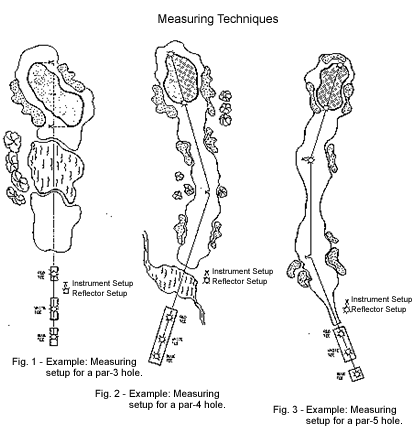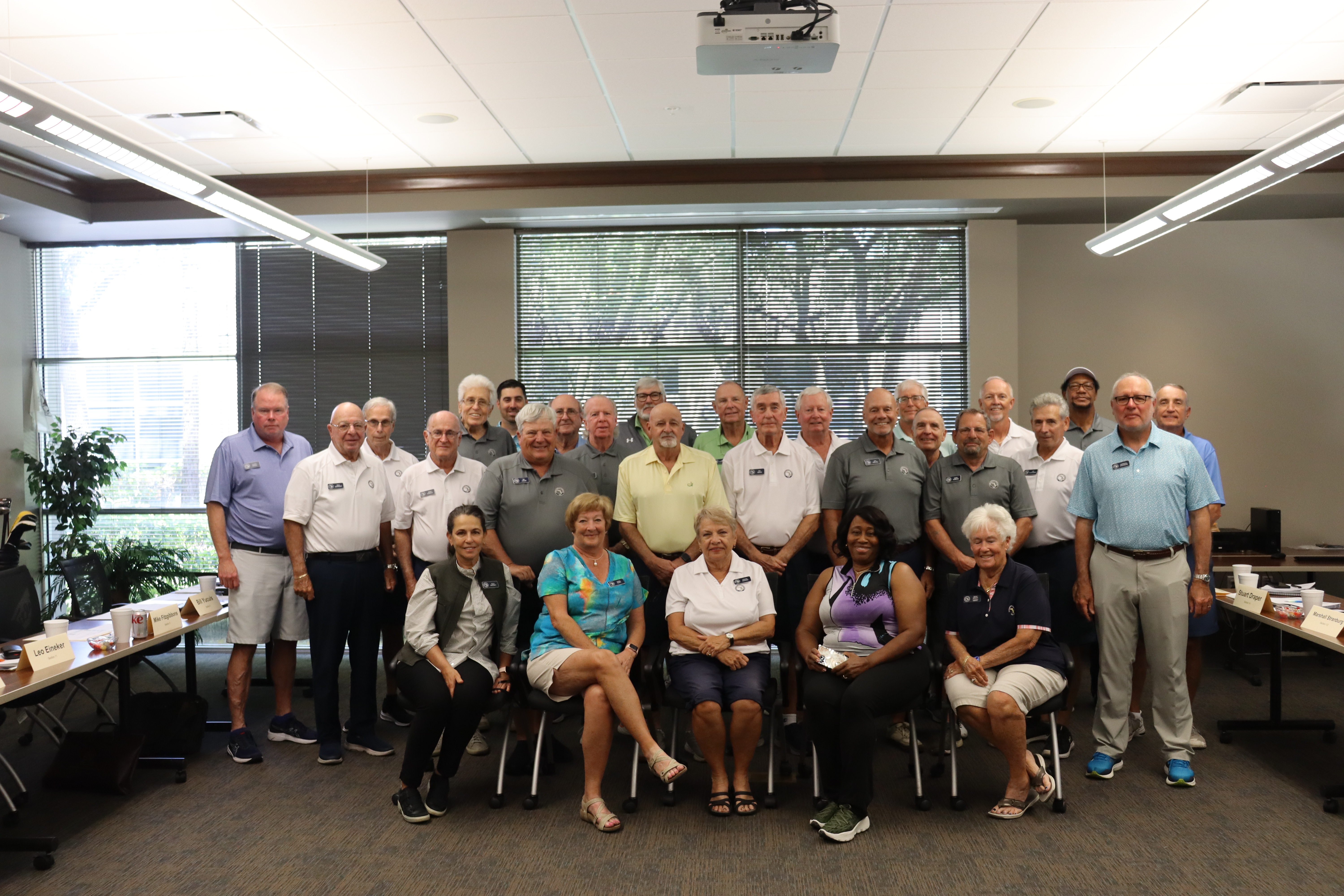What is a “Course Rating”?
When a golf course is rated, the rating team will evaluate the overall difficulty of the golf course for both a scratch golfer and a bogey golfer. The rating established for the scratch golfer is known as the Course Rating. There is also a rating for the bogey player known as the Bogey Rating. This Bogey Rating is not normally published but is used to determine a Slope Rating. Slope Rating; is the evaluation of the relative difficulty of a course for players other than scratch.
The Course Rating process requires the Course Rating team to evaluate the ten obstacles and effective length corrections for every hole. We recommend that each rating team play the golf course after the rating procedure to gain further insight into the overall difficulty of the golf course.
The Course and Slope Ratings are then calculated and certified by FSGA before they are issued to the corresponding golf club.
Definitions
In order to help understand the course rating process, below are some of the basic definitions used in the course rating process:
Bogey Golfer – A player with a Handicap Index of approximately 20.0 for men and approximately 24.0 for women. Under normal situations, the male bogey golfer can hit his tee shot 200 yards and reach a 370-yard hole in two shots. Likewise, the female bogey golfer can hit her tee shot 150 yards and reach a 280-yard hole in two shots.
Scratch Golfer – An amateur player who plays to 0.0 Handicap Index to the standard of the stroke play qualifiers competing in the United States Amateur Championship/Canadian Amateur. The male scratch golfer hits his tee shots an average of 250 yards and reaches a 470-yard hole in two shots. The female scratch golfer can hit her tee shots an average of 210 yards and reach a 400-yard hole in two shots.
Course Rating – An evaluation of the overall difficulty of the golf course under normal course and weather conditions for the scratch golfer. This figure is equal to the average of the better half of a scratch golfer score.
Bogey Course Rating – An evaluation of the overall difficulty of the golf course under normal course and weather conditions for the bogey golfer. The bogey rating is equal to the average of the better half of a bogey golfer’s score.
Slope Rating – An indication of the relative difficulty of a golf course for players who are not scratch players compared to players who are scratch players. The lowest Slope rating is 55, and the highest is 155. A golf course of standard playing difficulty has a Slope Rating of 113.
Effective Playing Length – The effective playing length for each golfer is derived by adding the measured yardage of the course to any adjustments made for elevation, roll, forced lay-ups, wind, and altitude. Adjustments are made to the measured yardage if there is any elevation change from tee to green (elevation), if there is a prevailing wind and is it a factor (wind), if the fairway landing areas are hard or soft, if the tee shots land into an up-slope or on a downslope (roll), if an obstacle or combination of obstacles prevents a golfer from playing a full-length shot (forced lay-up), and if the course is located more than 2000 feet above sea level (altitude).
Obstacle Stroke Value – The obstacle stroke value is a numerical evaluation of all obstacles (topography, fairway, green target, recovery and rough, bunkers, out of bounds, water, trees, green surface, and psychology) on the golf course. It is also highly probable that the Obstacle stroke value of the two golfers will be different. Generally, the nearer the obstacles are to the landing zones the higher the rating values.
Course Rating FAQ
Q. How often should a course be rated?
A course must be re-rated at least every ten years, even if it has not changed in any way. Courses will be contacted for a re-rating after 9 years have elapsed from the prior rating. Newly constructed courses change rapidly in the first few years, and must be be rated five years after the new course's initial rating.
Q: Where can I find the Course and Slope Ratings for a club?
A: There are a number of places to find the Course and Slope Ratings for a club. Official Course Rating certificates (for both men and women) should be posted at the golf course in an easily visible area. Most clubs also include the Course and Slope Ratings on their scorecard and website.
The FSGA website also offers a search tool where you can find all member courses in the province along with Course Rating and contact information: Simply click Search Clubs on the website.
Q: What is Slope Rating?
A: Slope Rating indicates the measurement of relative difficulty of a course for players who are not scratch golfers compared to the Course Rating. Slope Rating is computed from the difference between the Bogey Rating (playing difficulty for the bogey golfer) and Course Rating.
Q: Does a higher Slope Rating mean that it’s a more difficult course?
A: No, not necessarily. Slope Rating is a measurement of the relative difficulty of a course for players who are not scratch golfers compared to the Course Rating. This means that the higher the Slope Rating, the greater the difference is between the scratch and bogey players. Since Slope Rating is a relative measure, it is only accurate when considered in combination with the Course Rating.
Q: What factors are used in Course Rating?
- Yardage is the predominant factor in determining a USGA Course Rating.
- The effective playing length of a hole may be substantially different from its actual length, which includes roll, elevation, dogleg/forced lay-up, prevailing wind and altitude.
- Obstacle factors (bunkers, water, trees, etc.) are considered separately on their effect on the play of scratch and bogey on each hole.
Course management and maintenance must be consistent from day to day and month to month so that the USGA Course Ratings will remain valid.
Q: Course Rating Cost
- Courses with ratings where the previous rating occurred more than 9 years ago, on the GHIN System and two consecutive years of paid club dues - $0 for course rating services.
- Courses with ratings where the previous rating occurred less than 9 years ago - $2500 for course rating services.
- Courses not on the GHIN System - $2500 for course rating services
Q: Tee to Green Measurement Services
(No charge per 9 holes for GHIN clubs: $1500 per 9 holes for Non-GHIN clubs)
The starting point from which each hole is measured must be defined. Normally the middle of the teeing area is used. (See Course Set-up, Section 15-2.) Opposite this starting point, a visible permanent yardage marker such as a concrete slab, metal plate or pipe set flush with the ground must be installed at the side of the tee. Permanent markers are essential. It is recommended that the hole yardage be visible on the marker. Permanent yardage markers should be installed at the side of each set of tees. If alternate tee areas are used, it is important that permanent yardage markers be installed on each area.
On a nine-hole course, if separate tees or tee-markers are used for each nine of an 18-hole round, separate measurements, and permanent yardage markers shall be established for each nine. The yardage markers (and their respective tee-markers) for each nine should be uniquely identifiable.
Q: I score approximately the same on my two different courses but their Course and Slope Ratings are different. Why is that?
A: One reason for this could be that one of the clubs has recently been rated and has not posted their most current Course and Slope Rating, or that the club has not printed out new scorecards to reflect the recent rating results.
Another reason could be coincidental in that they have similar design characteristics that work well with your individual game and that the rounds you have played have happened to be around the same scores.
Q: What is the minimum length requirement be for a course and/or set of tees to be issued a Course Rating and Slope Rating?
A: In 2024, The World Handicap System has approved a low-end limit for courses to be issued a Course Rating and Slope Rating of 1,500 yards for 18-holes or 750 yards for 9-holes.

How We Measure
Each hole shall be measured horizontally (air line) by an electronic measurement device, or with steel tape or surveying instruments, from the permanent yardage marker for every teeing area on the golf course to the center of the green. The measurement is along the designed line of play. Any competent individual may perform course measurement, subject to review and checking by the golf association that issues Course Ratings under the World Handicap System to the golf club. Yardages on the scorecard should accurately reflect this measurement. Accurate measurements to the nearest yard are very important.
A hole with a dogleg shall be measured on a straight line from the tee to the center of the fairway at the dogleg. The measurement shall continue from that point on a straight line to the center of the green.
A single set of markers used on any hole to designate two courses should show both colors, or both sets of markers should be placed together to designate the teeing areas.
Where tees generally used by men are also used by women, there should be a women’s Course Rating and Slope Rating from those tees in order for women to post their scores accurately for handicap purposes. The procedure for posting a score from a set of unrated tees may be used by both men and women when they play a set of tees that has not been rated for the appropriate gender.
Please refer to Section 6 of the Course Rating Manual for complete details of course measurement procedures.
Q: How can I become a course rating volunteer?
A: To become a course rating volunteer, you must submit a profile form on the FSGA website. Once the application has been processed, you will be contacted by FSGA with information on the next stage of the process.
Course rating volunteers must take part in training that provides in-depth instruction about course rating practices and procedures.
Become a course rating volunteer
Should you have any questions, please contact dchau@fsga.org






